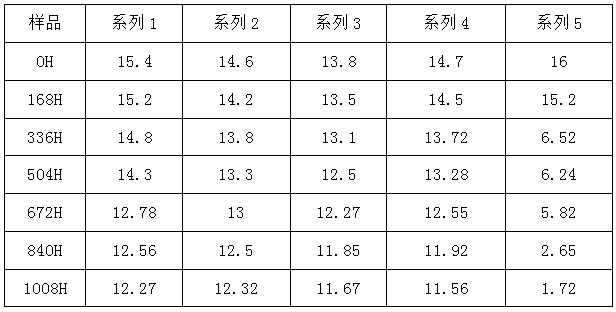Hydrolysis resistant polycarbonate composite material and preparation method thereof
A technology of polycarbonate and composite materials, which is applied in the field of hydrolysis-resistant polycarbonate composite materials and its preparation, can solve the problems of reduced service life and poor hydrolysis resistance, and achieves improved performance, excellent thermal deformation resistance, and excellent thermal deformation resistance. The effect of high temperature resistance and hydrolysis resistance
- Summary
- Abstract
- Description
- Claims
- Application Information
AI Technical Summary
Problems solved by technology
Method used
Image
Examples
Embodiment 1
[0023] A hydrolysis-resistant polycarbonate composite material, the raw material formula is: polycarbonate 48%, silicone polycarbonate copolymer 35%, antioxidant 0.5%, lubricant 3%, m-methylaniline 4%, containing Fluorine compound 6%, the rest is toughening agent.
[0024] Specifically, the silicone polycarbonate copolymer includes 30-65 parts of silicone polycarbonate copolymer A and 30-65 parts of silicone polycarbonate copolymer B.
[0025] Specifically, the molecular weight of the silicone polycarbonate copolymer A is 12000-18000, and the molecular weight of the silicone polycarbonate copolymer B is 15000-26000.
[0026] Specifically, the polycarbonate includes type A, type B, and type C, wherein the molecular weight of type A is 10,000-30,000, the molecular weight of type B is 15,000-18,000, and the molecular weight of type C is 22,000.
[0027] A preparation method of a hydrolysis-resistant polycarbonate composite material, comprising the following steps:
[0028] 1) A...
Embodiment 2
[0035] A kind of hydrolysis-resistant polycarbonate composite material and preparation method thereof as described in embodiment 1, can also adopt following technology:
[0036] The raw material formula is: polycarbonate 52%, silicone polycarbonate copolymer 30%, antioxidant 0.7%, lubricant 4%, m-methylaniline 3%, fluorine-containing compound 5%, and the rest is Toughener.
[0037] In step 2), the heating temperature is 102°C, and the reaction temperature is kept at 110°C.
[0038] In step 3), the heating temperature is 131°C, and the reaction temperature is kept at 142°C.
[0039] In step 5), the extrusion temperature of the independent section is 390°C, the extrusion temperature of the filling section is 470°C, and the extrusion temperature of the meshing section is 550°C.
Embodiment 3
[0041] A kind of hydrolysis-resistant polycarbonate composite material and preparation method thereof as described in embodiment 1, can also adopt following process:
[0042] The raw material formula is: polycarbonate 32%, silicone polycarbonate copolymer 42%, antioxidant 0.1%, lubricant 5%, m-methylaniline 5%, fluorine-containing compound 7%, and the rest is Toughener.
[0043] In step 2), the heating temperature is 135°C, and the reaction temperature is kept at 85°C.
[0044] In step 3), the heating temperature is 92°C, and the reaction temperature is kept at 157°C.
[0045] In step 5), the extrusion temperature of the independent section is 410°C, the extrusion temperature of the filling section is 420°C, and the extrusion temperature of the meshing section is 560°C.
PUM
| Property | Measurement | Unit |
|---|---|---|
| heat deflection temperature | aaaaa | aaaaa |
| heat deflection temperature | aaaaa | aaaaa |
Abstract
Description
Claims
Application Information
 Login to View More
Login to View More - R&D
- Intellectual Property
- Life Sciences
- Materials
- Tech Scout
- Unparalleled Data Quality
- Higher Quality Content
- 60% Fewer Hallucinations
Browse by: Latest US Patents, China's latest patents, Technical Efficacy Thesaurus, Application Domain, Technology Topic, Popular Technical Reports.
© 2025 PatSnap. All rights reserved.Legal|Privacy policy|Modern Slavery Act Transparency Statement|Sitemap|About US| Contact US: help@patsnap.com


